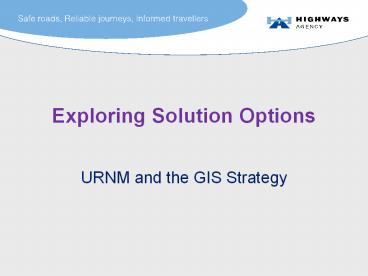Exploring Solution Options - PowerPoint PPT Presentation
1 / 26
Title: Exploring Solution Options
1
Exploring Solution Options
- URNM and the GIS Strategy
2
Centralised versus Distributed
- Data Architecture
3
Centralised
- Geospatial applications access a common
geodatabase - Network Model is centralised
- New applications have to be designed to use this
external database/schema - Migration issues for existing systems
4
Distributed
- Geospatial applications have their own local
database - Network model is distributed
- Needs a common schema for data exchange
- Eases migration issues for existing systems
5
Conflation
- Centralised Database Approach
6
Option 1 - Database Conflation COTS tools
- Requires bespoke development
- Expensive to develop and maintain
- Does nothing for HAs INSPIRE/ GIS Strategy
- Does not take account of TechPols for Data
Exchange or end-to-end SOA/SDI Architecture - Does not take account of HMG Policy on Open Source
7
Option 2 - Database Conflation Open Source
tools
- Does take account of HMG Policy on Open Source
Software - Eliminates licensing costs
- Requires bespoke development
- Expensive to develop and maintain (manpower)
- Does nothing for HAs INSPIRE/GIS Strategy
- Does not take account of TechPols for Data
Exchange or end-to-end SOA/SDI Architecture
8
Application support
- Centralised Database Approach
9
Applications consumingURNM Data Services
- Geospatial applications access a common
geodatabase - Network Model is centralised
- New applications have to be designed to use this
external database/schema - Migration issues for existing systems
- Not generic to all GIS applications and databases
- May not be suited to COTS-based solutions
10
conflation
- Distributed Database Approach
11
Layers of Transportation Data
- The State of the Network
- The Events Layer contains objects such as
vehicles moving across the network. - The Unified Road Network
- The Routing Layer contains more complex
features such as No exit, e.g. at the
intersection of a bridge and tunnel. - The Reference Network Layer contains all of the
base road data . This data has a linear spatial
representation and has an underlying topological
structure that defines the connectivity and
adjacency of links in the road network.
12
Ordnance Survey Mastermap Layers
- The Imagery layer contains 24-bit raster
graphics. - The rest are features in Geographic Markup
Language (GML). - Unique common reference feature (TOID).
13
Application support
- Distributed Database Approach
14
Option 1 - GO Publisher
- Provides an INSPIRE/OGC-compliant Publishing
service. - Leaves existing databases in situ minimal
impact. - Treats GIS as a special case doesnt re-use
generic XML common services.
15
Option 2 Cascading WFS (1)
16
Option 2 Cascading WFS (2)
- Provides an INSPIRE/OGC-compliant Publishing
service. - Leaves existing databases in situ but requires
upgrade to WFS. - Treats GIS (GML) the same as other generic XML
data exchanges. - Builds on
- OS MasterMap layers.
- EA Technology Policy Framework
- Common Information Model.
- Enterprise Service Bus.
- Inter-System Data Exchange.
- Internal GIS/Geospatial Interfaces.
17
From Bespoke applications to cots
- GIS Applications (Consumers)
18
HAPMS As-Is
- Based on Pitney Bowes Insight Confirm COTS
package. - Supports multiple application modules including
- SWEEP
- Whole-Life Costs
- Scheduled Road Works
- Accident Records and
- Delay Cost Model.
- Not all in-scope for IAM Programme .
19
Network Delivery DevelopmentIAM COTS Example
Main candidates Pitney Bowes Insight (Confirm),
Exor, Symology.
20
TI2011 Move towards COTS?
- e.g. ITIS Holdings - TrafficScience
21
INM - Move towards COTS
- CUTLAS is fully compliant with UTMC
specifications. - Integrates data from traffic control, street
asset and other traffic/highway-related
subsystems. - Implements high performance ENVITIA MapLink
command and control to provide full GIS
capability.
22
UTMC-IAM Integration
Case Study Oxfordshire County Council
23
Standards-based Integration
- Service-Oriented Architecture (SOA).
- Enterprise Service Bus (ESB).
- Incremental Deployment.
- Re-use of Legacy Systems which still provide
business value. - Sweat assets instead of wholesale rip and
replace. - Reduce costs.
24
Typical COTS Features
- GIS User Interface
- Support for leading Spatial Databases
- Support for OGC standards WMS, WFS, etc.
- Flexible Web Services
- OS MasterMap ITN support
- Snap to OS MasterMap facility
- Support for the Traffic Management Act (TMA)
- Network Definition Management with multiple
linear referencing - Compliance/Integration with BS7666 National
Land Property Gazetteer - 2-way transmission of EToN Notices
- Spatial representation Management of
- Link/Node Network structures
- Street Gazetteer
- Associated street data
- UK PMS Defects Treatments
- Street works
- Traffic pinch points
- Import/Export and maintenance of NSG
25
Common Denominators
- GIS User Interface
- Spatial Data Infrastructure
- Spatial database
- Standard OGC Web Services
- Modular design
- Open interfaces
- Multiple location referencing systems may be
overlaid with automatic translation from one
referencing system to another.
26
Conclusions
- URNM was originally conceived against an As-Is
Architecture with 22 siloed solutions. - The To-Be Architecture is converging on two
COTS-based Application Frameworks - NDD IAM (currently out to OJEU)
- TMD Integrated Network Management is rolling out
Envitias Cutlas (UTMC) system. - Each of these are converging on Open standards
such as OGC Web Services. - OGC supports a Distributed Architecture.
- INSPIREs Transformation Services allow
organisations to meet their legal obligation
whilst ensuring continuity of their existing
business systems. - URNM needs to ensure it doesnt reinvent the
wheel and aligns with EA Principle of Re-use
before buy before build. - URNM should be
- A Data Exchange Model (PIM/PSM)
- A subset of the Generic Common Information Model
- An INSPIRE-compliant Public GML Schema.































